Related Research Articles

Octavia Estelle Butler was an American science fiction author and a multiple recipient of the Hugo and Nebula awards. In 1995, Butler became the first science-fiction writer to receive a MacArthur Fellowship.

Renee Cox is a Jamaican-American artist, photographer, lecturer, political activist and curator. Her work is considered part of the feminist art movement in the United States. Among the best known of her provocative works are Queen Nanny of the Maroons, Raje and Yo Mama's Last Supper, which exemplify her Black Feminist politics. In addition, her work has provoked conversations at the intersections of cultural work, activism, gender, and African Studies. As a specialist in film and digital portraiture, Cox uses light, form, digital technology, and her own signature style to capture the identities and beauty within her subjects and herself.
Obeah, or Obayi, is a series of African diasporic spell-casting and healing traditions found in the former British colonies of the Caribbean. These traditions derive much from traditional West African practices that have undergone cultural creolization. There is much regional variation in the practice of Obeah, which is followed by practitioners called Obeahmen and Obeahwomen.
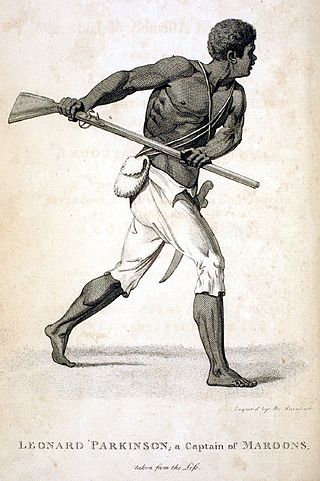
Maroons are descendants of Africans in the Americas and Islands of the Indian Ocean who escaped from slavery and formed their own settlements. They often mixed with indigenous peoples, eventually evolving into separate creole cultures such as the Garifuna and the Mascogos.

Queen Nanny, Granny Nanny, or Nanny of the Maroons ONH, was an 18th-century leader of the Jamaican Maroons. She led a community of formerly enslaved Africans called the Windward Maroons. In the early 18th century, under the leadership of Nanny, the Windward Maroons fought a guerrilla war over many years against British authorities in the Colony of Jamaica in what became known as the First Maroon War.
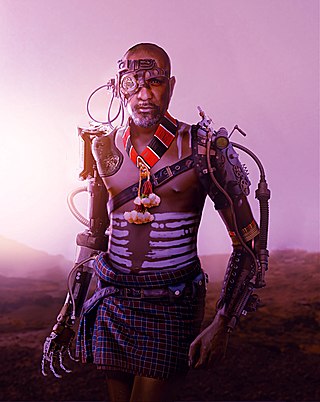
Afrofuturism is a cultural aesthetic, philosophy of science, and history that explores the intersection of the African diaspora culture with science and technology. It addresses themes and concerns of the African diaspora through technoculture and speculative fiction, encompassing a range of media and artists with a shared interest in envisioning black futures that stem from Afro-diasporic experiences. While Afrofuturism is most commonly associated with science fiction, it can also encompass other speculative genres such as fantasy, alternate history, and magic realism. The term was coined by Mark Dery, an American Cultural critic in 1993 and explored in the late 1990s through conversations led by Alondra Nelson.
Afro-Caribbean people or African Caribbean are Caribbean people who trace their full or partial ancestry to sub-Saharan Africa. The majority of the modern Afro-Caribbean people descend from the Africans taken as slaves to colonial Caribbean via the trans-Atlantic slave trade between the 15th and 19th centuries to work primarily on various sugar plantations and in domestic households. Other names for the ethnic group include Black Caribbean, Afro or Black West Indian or Afro or Black Antillean. The term Afro-Caribbean was not coined by Caribbean people themselves but was first used by European Americans in the late 1960s.

Parable of the Sower is a 1993 speculative fiction novel by American writer Octavia E. Butler. It is set in a post-apocalyptic Earth heavily affected by climate change and social inequality. The novel follows Lauren Olamina, a young woman who can feel the pain of others and becomes displaced from her home. Several characters from various walks of life join her on her journey north and learn of a religion she has discovered and titled Earthseed. The main tenets of Earthseed are that "God is Change" and believers can "shape God" through conscious effort to influence the changes around them. Earthseed also teaches that it is humanity's destiny to inhabit other planets and spread the "seeds" of the Earth.
Jamaican Maroons descend from Africans who freed themselves from slavery on the Colony of Jamaica and established communities of free black people in the island's mountainous interior, primarily in the eastern parishes. Africans who were enslaved during Spanish rule over Jamaica (1493–1655) may have been the first to develop such refugee communities.

Black science fiction or black speculative fiction is an umbrella term that covers a variety of activities within the science fiction, fantasy, and horror genres where people of the African diaspora take part or are depicted. Some of its defining characteristics include a critique of the social structures leading to black oppression paired with an investment in social change. Black science fiction is "fed by technology but not led by it." This means that black science fiction often explores with human engagement with technology instead of technology as an innate good.
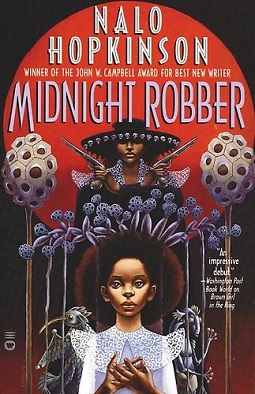
Midnight Robber is a science fiction bildungsroman by Jamaican-Canadian writer Nalo Hopkinson. Warner Aspect published the novel in 2000.

Bloodchild and Other Stories is the only collection of science fiction stories and essays written by American writer Octavia E. Butler. Each story and essay features an afterword by Butler. "Bloodchild", the title story, won the Hugo Award and Nebula Award.
Moore Town is a Maroon settlement located in the Blue Mountains and John Crow Mountains of Portland, Jamaica, accessible by road from Port Antonio. The easternmost Maroon town, Moore Town is located in the eastern end of the parish. Formerly known as New Nanny Town, Moore Town was founded in 1740 when the Peace Treaty was signed between the British colonial authorities and the Windward Maroons. This treaty allotted the Moore Town Maroons 1000 acres, but Moore Town only received 500. In 1781 the initial 500 acres was augmented with another 500 acres, taking their communal land up to 1,000 acres.
For a history of Afro-Caribbean people in the UK, see British African Caribbean community.

Climate fiction is literature that deals with climate change. Generally speculative in nature but inspired by climate science, works may take place in the world as we know it, in the near future or in fictional worlds experiencing climate change. The genre frequently includes science fiction and dystopian or utopian themes, imagining the potential futures based on how humanity responds to the impacts of climate change. The genre typically focuses on anthropogenic climate change and other environmental issues as opposed to weather and disaster more generally. Technologies such as climate engineering or climate adaptation practices often feature prominently in works exploring their impacts on society.
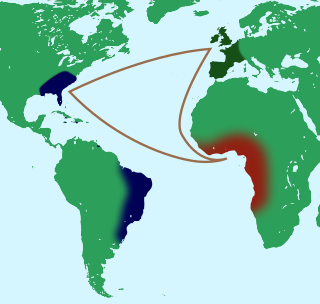
Flying Africans are figures of African diaspora legend who escape enslavement by a magical passage back over the ocean. Most noted in Gullah culture, they also occur in wider African-American folklore, and in that of some Afro-Caribbean peoples.

The Sierra Leone Creole people are an ethnic group of Sierra Leone. The Sierra Leone Creole people are descendants of freed African-American, Afro-Caribbean, and Liberated African slaves who settled in the Western Area of Sierra Leone between 1787 and about 1885. The colony was established by the British, supported by abolitionists, under the Sierra Leone Company as a place for freedmen. The settlers called their new settlement Freetown. Today, the Sierra Leone Creoles are 1.2 percent of the population of Sierra Leone.Sierra Leone.
Krista Franklin is an American poet and visual artist, whose main artistic focus is collage. Her work, which addresses race, gender, and class issues, combines personal, pop-cultural, and historical imagery.
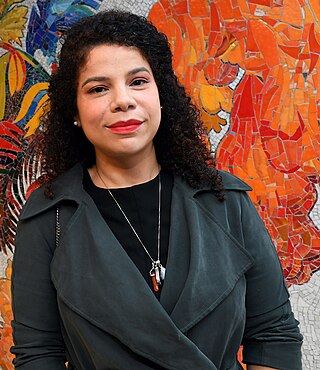
Firelei Báez is a Dominican Republic-born, New York City-based artist known for intricate works on paper and canvas, as well as large scale sculpture. Her art focuses on untold stories and unheard voices, using portraiture, landscape, and design to explore the Western canon.
Joseph Adekunle Olubo, was an artist and book illustrator active in the 1980s. He participated in some of the first art exhibitions organized by Black British artists in the United Kingdom. Olubo was one of 22 artists included in the 1983 inaugural exhibition, Heart in Exile, at The Black-Art Gallery, an art space in London which worked with artists of African and Caribbean backgrounds.
References
- ↑ Lewin, Paul. "Biography". Paul Lewin. Retrieved 2017-03-25.
- 1 2 3 Burlison, Dani (August 4, 2015). "Paul Lewin Continues Storytelling Tradition Through Painting". KQED Arts. Retrieved 2017-03-25.
- ↑ "Interview with Paul Lewin Afro-Caribbean Sci-Fi Contemporary PainterAfrican Digital Art". African Digital Art. 2022-04-04. Retrieved 2023-12-13.
- ↑ Valrey, JR (February 12, 2016). "The art of painter Paul Lewin". sfbayview.com. Retrieved 2017-03-25.
- ↑ Ono, Betti (2015-07-16). "August 7 – Sept 13, 2015 • Roots of the Cotton Tree: Works by Paul Lewin" . Retrieved 2017-03-25.
- ↑ Ono, Betti (2015-07-16). "August 7 – Sept 13, 2015 • Roots of the Cotton Tree: Works by Paul Lewin". CELEBRATING 6 YEARS OF ART, CULTURE & COMMUNITY. Retrieved 2017-03-25.
- ↑ White, Erin (January 27, 2016). "FEATURE: The life and legacy of Black Feminist Sci-Fi Pioneer Octavia E. Butler to be honored with week-long exhibition, 'Octavia's Attic: ARTifacts From Our Possible Futures' – AFROPUNK". www.afropunk.com. Retrieved 2017-03-25.
- ↑ "Seven Stories Press". www.sevenstories.com. Retrieved 2017-03-25.